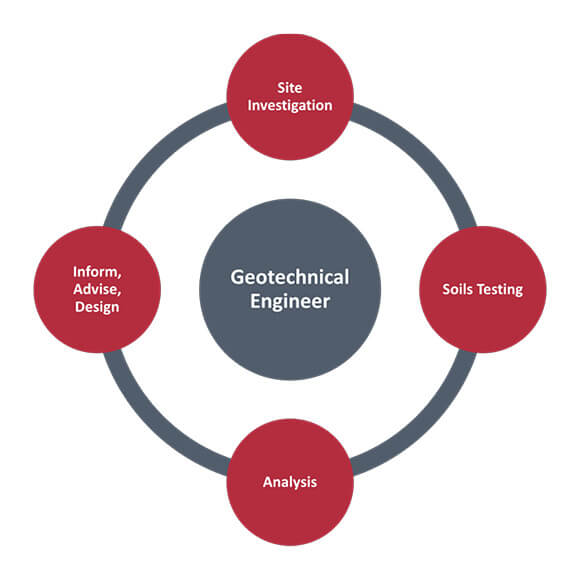The Only Guide for Geotheta
The Only Guide for Geotheta
Blog Article
Our Geotheta Statements
Table of ContentsSome Known Factual Statements About Geotheta Getting My Geotheta To WorkWhat Does Geotheta Do?The 4-Minute Rule for Geotheta
They collaborate with civil engineers, structural engineers, engineers, and various other experts to integrate geotechnical considerations right into the total job style and building and construction process. This needs effective teamwork, coordination, and communication to make sure that the geotechnical elements line up with the project purposes and satisfy regulative needs.Mining & Materials Design: Concepts of drilling, infiltration prices, and elements influencing the choice of boring approach. Qualities of explosives, firing systems and blast patterns. Blowing up methods in surface area and underground workings. Unique blasting strategies at excavation boundaries. Resonance and sound control. Mechanical and continual methods to fragmentation, including longwall shearing and fullface boring.
Modelling of fragment and bit dimension distributions; comminution as a transfer feature. Comminution innovation: squashing, grinding, size category. Integrated analysis of fragmentation and comminution procedures. Provided by: Mining & Products Engineering.
The smart Trick of Geotheta That Nobody is Talking About
Bachelor's level programs in civil, geotechnical, geological, and ecological design normally last 4 years and consist of basic education programs in English, social scientific research, and the liberal arts, as well as programs in sophisticated maths, structural geology, and liquid mineralogy. (http://prsync.com/geotheta/)
Geotechnical engineering includes the analysis of the soil and rock conditions at a certain site, and their effects for the development of that website. As a lot of frameworks count on the ground for support, it is without shock that a detailed understanding of the ground conditions, and the viability of structure systems, are vital to the long-lasting security and efficiency of the structure or framework.
Specialising in the investigation of geological formations and ground practices, geotechnical designers perform scientific investigations and testing to recognize the influence these geological developments might have on the design and building of structure, civil and facilities tasks. This know-how is crucial for the design and building of buildings, roads, tunnels, dams, bridges, and supply of water and sewage systems.
The geotechnical team at Douglas Partners routinely consult with architects, design designers, programmers, and contractors to make recommendations on design and advancement proposals to ensure that the built structures are suitably developed for the ground conditions. The layout of footing systems requires to consider the weight of the structure, the capacity of the ground to sustain that weight together with movement resistances and effective building.
What Does Geotheta Do?
This job is considerably simplified by the use our Douglas Map geospatial system which makes this details readily accessible in a simple to use web internet browser interface. A geotechnical designer will guide the drilling of boreholes and examination pits to accumulate soil and various other samples, and likewise evaluate surface area features and ground exposures to create a geotechnical model of the subsurface problems.
Depending on the project kind and ground problems came across, laboratory testing might among various other points analyze stamina, compressibility, reactivity and/or permeability of soil and rock examples. Hereafter data is gathered and collected, the outcomes are utilized for a geotechnical version of the site, which is normally offered as sections across the site.

A geotechnical investigation by nature can only examine the ground problems at the areas pierced or excavated. Natural variations in soil and rock problems can happen throughout a website and in between test locations. It is for that reason great technique that the geotechnical designer be preserved throughout building and construction of the task to supply on-site confirmation that the ground problems encountered follow the expectations and advice provided in the geotechnical investigation record.
Not known Facts About Geotheta
Geotechnical designers utilize their comprehensive understanding of soil and rock to assess threat and fix issues on diverse framework projectsGeotechnical engineering is a specialist branch of civil design which considers the practices of planet products and the application of soil and rock technicians. Consulting Engineer. As a geotechnical engineer, you will certainly analyze the physical, mechanical and chemical buildings of soil and rock in order to develop structures, maintaining structures and earthworks
Geotechnical design is carefully connected to and overlaps with, both engineering geology and ground design - https://dzone.com/users/5183482/geotheta.html. It's feasible to specialise in geotechnics or benefit a geotechnical company however be called an engineering rock hound or a ground designer. As a geotechnical designer, you'll require to: develop and preserve partnerships with clients and other professionals involved in the website, throughout each projectmaintain safety requirements on site be conscious of price effects when you make recommendationsstudy geological maps and airborne photographs from a series of resources and from various time periodsexamine construction plans to see exactly how viable Click This Link they are based upon your understanding of the siteinvestigate dangers or geological dangers for the sitesearch for environmentally sensitive attributes, such as garbage dump beginning to establish factual and expository ground modelsplan area investigationsdrill and analyse examples of bedrock, dirt, groundwater and extra materials manage various other professionals on sitesolve technical issues as they develop, such as unanticipated frameworks at drill sitesmonitor problems during and after construction to see to it structures are secure in the short and lengthy termadding data accumulated on site to your first researchcreating geotechnical calculations, drawings, and two or three-dimensional computer system models translating the datamaking recommendations regarding the recommended use of the site

Report this page